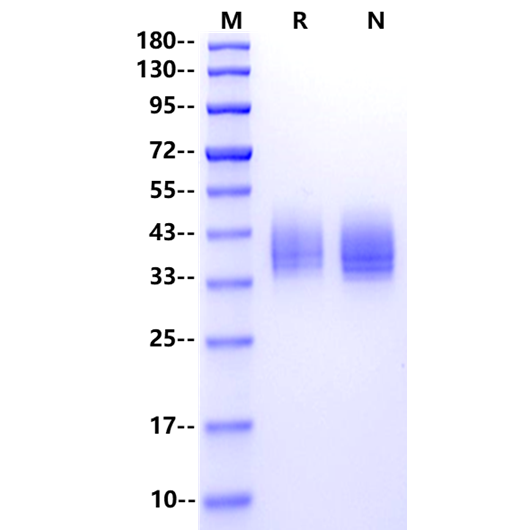Product Details
Product Details
Product Specification
| Species | Mouse |
| Accession | P20352 |
| Amino Acid Sequence | Ala29-Glu251, with C-terminal 8*His AGIPEKAFNLTWISTDFKTILEWQPKPTNYTYTVQISDRSRNWKNKCFSTTDTECDLTDEIVKDVTWAYEAKVLSVPRRNSVHGDGDQLVIHGEEPPFTNAPKFLPYRDTNLGQPVIQQFEQDGRKLNVVVKDSLTLVRKNGTFLTLRQVFGKDLGYIITYRKGSSTGKKTNITNTNEFSIDVEEGVSYCFFVQAMIFSRKTNQNSPGSSTVCTEQWKSFLGEGGGSHHHHHHHH |
| Expression System | HEK293 |
| Molecular Weight | 35-45kDa (Reducing) |
| Purity | >95% by SDS-PAGE |
| Endotoxin | <0.1EU/μg |
| Conjugation | Unconjugated |
| Tag | His Tag |
| Physical Appearance | Lyophilized Powder |
| Storage Buffer | PBS, pH7.4 |
| Reconstitution | Reconstitute at 0.1-1 mg/ml according to the size in ultrapure water after rapid centrifugation. |
| Stability & Storage | · 12 months from date of receipt, lyophilized powder stored at -20 to -80℃. · 3 months, -20 to -80℃ under sterile conditions after reconstitution. · 1 week, 2 to 8℃ under sterile conditions after reconstitution. · Please avoid repeated freeze-thaw cycles. |
Background
Tissue factor (TF) is an integral membrane protein that is essential to life. It is the high-affinity receptor and cofactor for factor (F)VII/VIIa and plays a primary role in both normal hemostasis and thrombosis. TF is a transmembrane glycoprotein with a 219-amino acid extracellular domain, a 23-residue transmembrane region, and a 21-residue intracellular domain. With a vascular injury, TF becomes exposed to blood and binds plasma factor VIIa, and the resulting complex initiates a series of enzymatic reactions leading to clot formation and vascular sealing. In cancer patients, tumors release TF-positive microvesicles into the circulation that may contribute to venous thrombosis. TF also has nonhemostatic roles. For instance, TF-dependent activation of the coagulation cascade generates coagulation proteases, such as FVIIa, FXa, and thrombin, which induce signaling in a variety of cells by cleavage of protease-activated receptors.
Picture
Picture
SDS-PAGE



